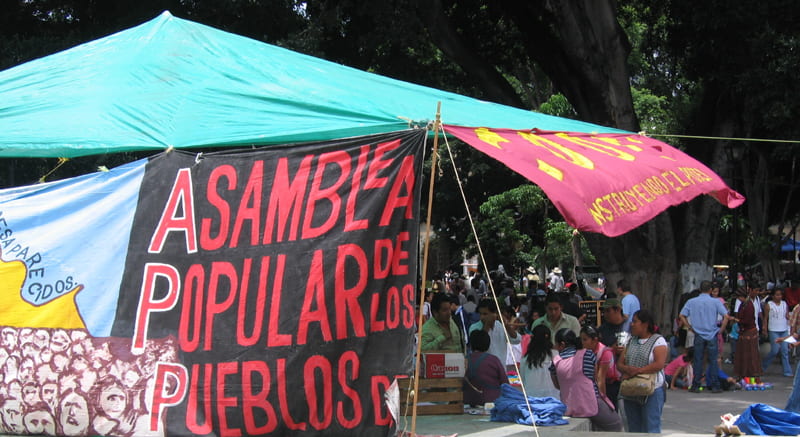
Rights Histories in Oaxaca
Media For Rights Histories in Oaxaca
English Translation
Spanish Translation
- La historia de los derechos humanos, de las mujeres y de los indígenas en el Estado de Oaxaca
- El movimiento social oaxaqueño del 2006: Una cronología audiovisual de junio a noviembre del 2006
- Violaciónes de Derechos Humanos en Oaxaca
- Medios, Género, y Radio Indígena y Comunitaria
- Impactos Políticos e Económicas del Conflicto
- Activismo Indígena
- Jóvenes Organizando y Arte Para el Pueblo

While it is true that in 2000 Mexico ousted the Revolutionary Institutional Party (PRI) from presidential power after an uninterrupted 70-year rule, the state of Oaxaca has remained rooted in an authoritarian political model in which the PRI—and other parties—use selective and at times widespread repression, manipulation of the justice system, and political corruption to perpetuate control. The Mexican constitution provides for freedom of speech, the protection of women´s rights and racial equality with specific mention of indigenous peoples, yet these ideological principles expressed in the letter of the law are juxtaposed with a contradictory reality. The powerful elite of Oaxaca has maintained control of political and economic processes through a regional culture that speaks the discourse of equality while denying the very people whose rights the constitution is meant to defend—women, indigenous, poor and other marginalized peoples—access to the resources, public spaces and legitimacy that would be necessary to exercise such rights.
Yet these same marginalized groups have continued to gain awareness of their rights due to exposure to the discourse of organizations like the Mexican National Human Rights Commission, the Oaxaca Human Rights Commission, and most importantly from their strong social movements and the work of the NGO sector.
The Oaxaca social movement of 2006 was born out of a complex history of prior movements and rights discourses in Oaxaca from the 1970s to the present. This chapter includes six background video-testimonials of leaders familiar with the histories of the different rights movements that preceded and became unified in the 2006 movement.
The rights movements and organizing efforts discussed include indigenous rights, women’s rights and women’s movements, human rights, popular media organizing, and teacher’s union Local 22 (Sección 22) of the National Union for Education Workers (Sindicato Nacional de Trabajadores de la Educación, SNTE). Local 22 joined other union locals in forming a dissident federation within the SNTE, known as the Coordinadora Nacional de Trabajadores de la Educación (National Coordinator of Education Workers or CNTE). The mission of the CNTE is to democratize the SNTE, to democratize educational practices at the national level, and ultimately the entire country.
This section also includes a photo archive of artistic expressions of the movement found in public places—stencils, murals, graffiti and other forms—as well as an archive of Local 22 posters from different time periods.

